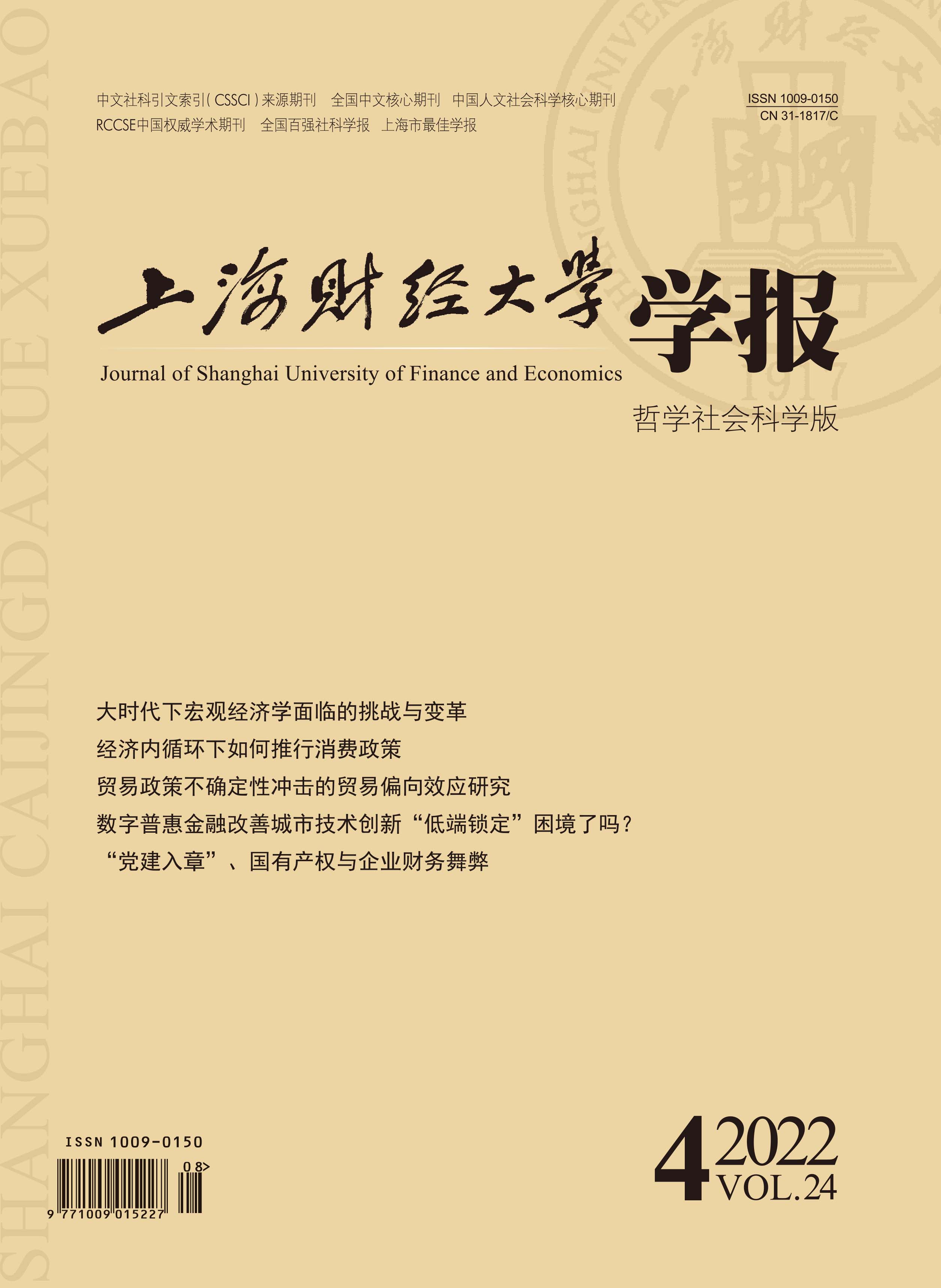数字普惠金融促进经济社会包容性发展已备受关注,其技术创新效应如何亦成为数字经济时代城市创新发展不可忽视的重要议题。文章利用2011—2018年中国270个地级及以上城市的面板数据,实证考察了数字普惠金融对城市技术创新的影响及其作用机制。结论表明:首先,数字普惠金融能够改善我国城市技术创新及其“低端锁定”困境,使得城市更倾向于进行含有高端技术的实质性创新。其次,机制方面,在供给侧,数字普惠金融能够缓解区域融资信贷约束(提高银行业竞争力、促进传统金融供给),从而促进城市总体技术创新、高端技术创新和低端技术创新;在需求侧,提升市场消费需求(促进消费结构升级和消费规模扩张)是数字普惠金融促进城市高端技术创新的重要渠道,但对城市总体技术创新和低端技术创新的渠道效应不显著。最后,数字普惠金融改善城市技术创新“低端锁定”困境的正外部效应在高市场化与高互联网水平城市中更为明显,同时对低市场化水平、低互联网水平城市的总体技术创新存在“雪中送炭”效应。研究结论为有效发挥数字普惠金融服务城市创新和协调发展提供了稳健的经验证据。
数字普惠金融改善城市技术创新“低端锁定”困境了吗?
摘要
参考文献
8 刘斌, 李川川, 李秋静. 新发展格局下消费结构升级与国内价值链循环: 理论逻辑和经验事实[J]. 财贸经济,2022,(3). DOI:10.3969/j.issn.1002-8102.2022.03.009
12 施炳展, 李建桐. 互联网是否促进了分工: 来自中国制造业企业的证据[J]. 管理世界,2020,(4). DOI:10.3969/j.issn.1002-5502.2020.04.014
13 司登奎, 李小林, 孔东民, 等. 贸易政策不确定性、金融市场化与企业创新型发展: 兼论金融市场化协同效应[J]. 财贸经济,2022,(4). DOI:10.3969/j.issn.1002-8102.2022.04.010
14 司登奎, 李小林, 赵仲匡. 非金融企业影子银行化与股价崩盘风险[J]. 中国工业经济,2021,(6). DOI:10.3969/j.issn.1006-480X.2021.06.010
15 唐松, 伍旭川, 祝佳. 数字金融与企业技术创新——结构特征、机制识别与金融监管下的效应差异[J]. 管理世界,2020,(5). DOI:10.3969/j.issn.1002-5502.2020.05.013
16 陶锋, 赵锦瑜, 周浩. 环境规制实现了绿色技术创新的“增量提质”吗——来自环保目标责任制的证据[J]. 中国工业经济,2021,(2). DOI:10.3969/j.issn.1006-480X.2021.02.004
23 应千伟, 何思怡. 政府研发补贴下的企业创新策略: “滥竽充数”还是“精益求精”?[J]. 南开管理评论,2022,(2). DOI:10.3969/j.issn.1008-3448.2022.02.002
25 赵卫亚. 中国城镇居民消费函数的变系数Panel Data模型[J]. 数量经济技术经济研究,2003,(11). DOI:10.3969/j.issn.1000-3894.2003.11.020
26 郑万腾, 赵红岩, 范宏. 数字金融发展对区域创新的激励效应研究[J]. 科研管理,2021,(4). DOI:10.19571/j.cnki.1000-2995.2021.04.015
27 Aziz A, Naima U. Rethinking digital financial inclusion: Evidence from Bangladesh[J]. Technology in Society,2021,64:101509. DOI:10.1016/j.techsoc.2020.101509
28 Cao S P, Nie L, Sun H P, et al. Digital finance, green technological innovation and energy-environmental performance: Evidence from China’s regional economies[J]. Journal of Cleaner Production,2021,327:129458. DOI:10.1016/j.jclepro.2021.129458
29 Demertzis M, Merler S, Wolff G B. Capital markets union and the fintech opportunity[J]. Journal of Financial Regulation,2018,4(1):157–165. DOI:10.1093/jfr/fjx012
30 Demir A, Pesqué-Cela V, Altunbas Y, et al. Fintech, financial inclusion and income inequality: A quantile regression approach[J]. The European Journal of Finance,2022,28(1):86–107. DOI:10.1080/1351847X.2020.1772335
31 Fisman R, Love I. Financial dependence and growth revisited[J]. Journal of the European Economic Association,2007,5(2–3):470–479. DOI:10.1162/jeea.2007.5.2-3.470
32 Fuster A, Plosser M, Schnabl P, et al. The role of technology in mortgage lending[J]. The Review of Financial Studies,2019,32(5):1854–1899. DOI:10.1093/rfs/hhz018
33 Gomber P, Koch J A, Siering M. Digital finance and FinTech: Current research and future research directions[J]. Journal of Business Economics,2017,87(5):537–580. DOI:10.1007/s11573-017-0852-x
34 Hau H, Huang Y, Shan H Z, et al. FinTech credit and entrepreneurial growth[R]. Swiss Finance Institute, 2021.
35 Honoré B E. Trimmed LAD and least squares estimation of truncated and censored regression models with fixed effects[J]. Econometrica,1992,60(3):533–565. DOI:10.2307/2951583
36 Hsu P H, Tian X, Xu Y. Financial development and innovation: Cross-country evidence[J]. Journal of Financial Economics,2014,112(1):116–135. DOI:10.1016/j.jfineco.2013.12.002
37 Jiang X X, Wang X, Ren J, et al. The nexus between digital finance and economic development: Evidence from China[J]. Sustainability,2021,13(13):7289. DOI:10.3390/su13137289
38 Kogan L, Papanikolaou D, Seru A, et al. Technological innovation, resource allocation, and growth[J]. The Quarterly Journal of Economics,2017,132(2):665–712. DOI:10.1093/qje/qjw040
39 Li J, Wu Y, Xiao J J. The impact of digital finance on household consumption: Evidence from China[J]. Economic Modelling,2020,86:317–326. DOI:10.1016/j.econmod.2019.09.027
40 Lin M F, Prabhala N R, Viswanathan S. Judging borrowers by the company they keep: Friendship networks and information asymmetry in online peer-to-peer lending[J]. Management Science,2013,59(1):17–35. DOI:10.1287/mnsc.1120.1560
41 Luo S M, Sun Y K, Yang F, et al. Does fintech innovation promote enterprise transformation? Evidence from China[J]. Technology in Society,2022,68:101821. DOI:10.1016/j.techsoc.2021.101821
42 Norden L, Silva Buston C, Wagner W. Financial innovation and bank behavior: Evidence from credit markets[J]. Journal of Economic Dynamics and Control,2014,43:130–145. DOI:10.1016/j.jedc.2014.01.015
43 Priem R L, Li S L, Carr J C. Insights and new directions from demand-side approaches to technology innovation, entrepreneurship, and strategic management research[J]. Journal of Management,2012,38(1):346–374. DOI:10.1177/0149206311429614
46 Teece D J. Business models, business strategy and innovation[J]. Long Range Planning,2010,43(2–3):172–194. DOI:10.1016/j.lrp.2009.07.003
47 Yu C J, Jia N, Li W Q, et al. Digital inclusive finance and rural consumption structure – evidence from Peking University digital inclusive financial index and China household finance survey[J]. China Agricultural Economic Review,2022,14(1):165–183. DOI:10.1108/CAER-10-2020-0255
引用本文
董春风, 司登奎. 数字普惠金融改善城市技术创新“低端锁定”困境了吗?[J]. 上海财经大学学报, 2022, 24(4): 62-77.
导出参考文献,格式为:





 7587
7587  7616
7616

